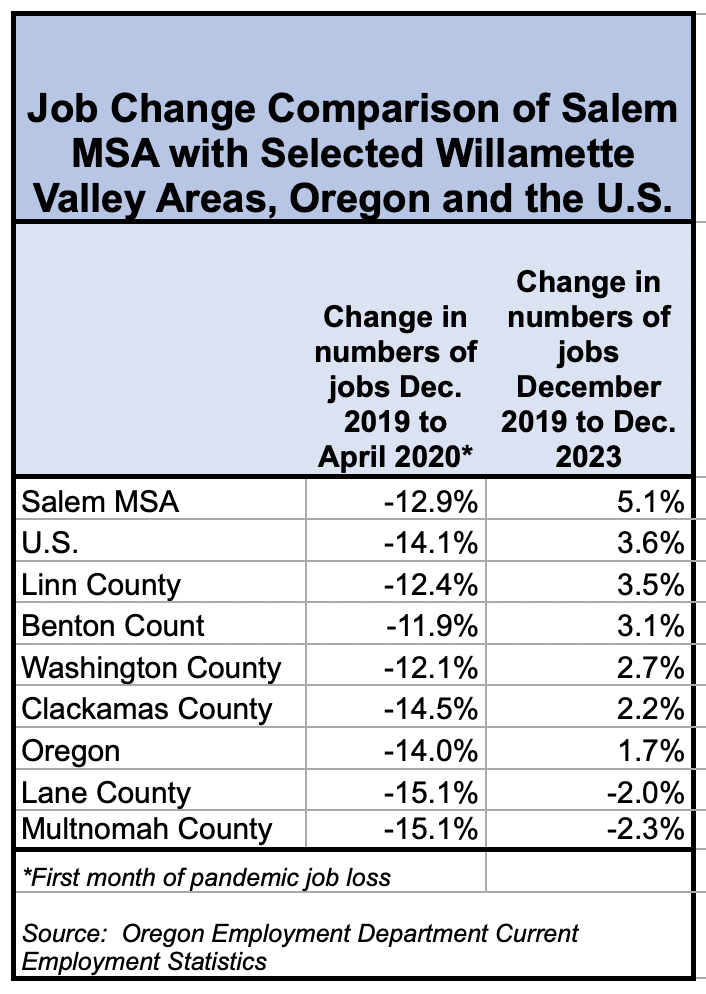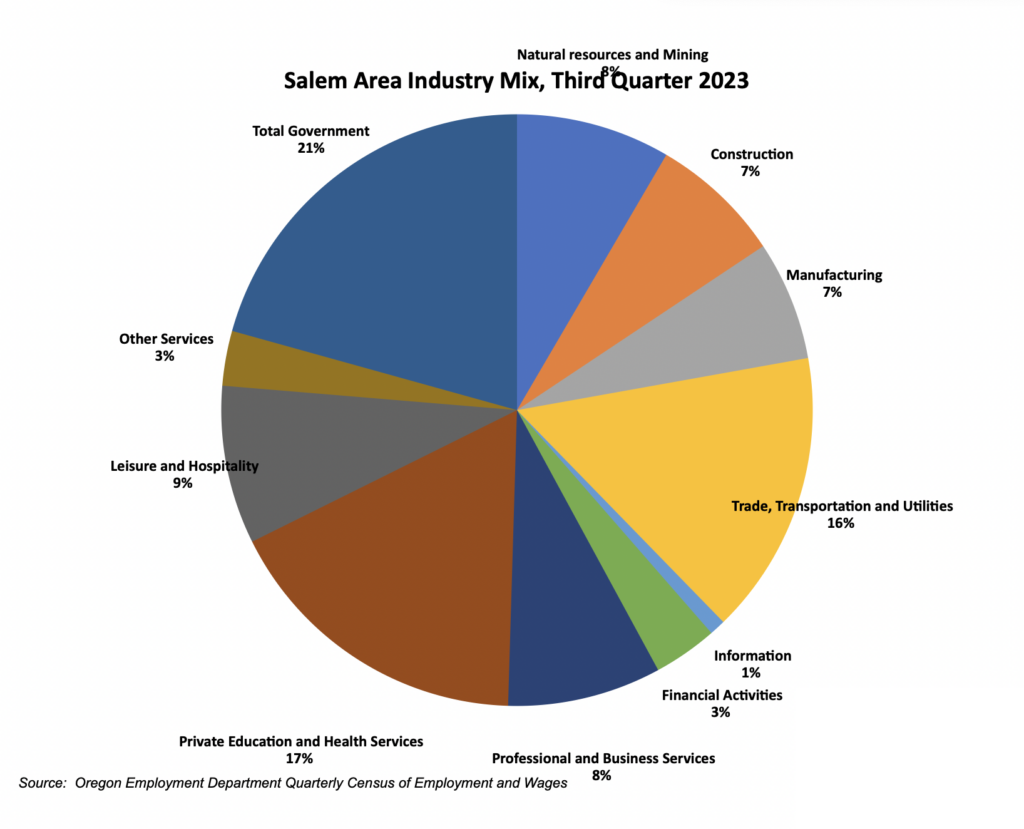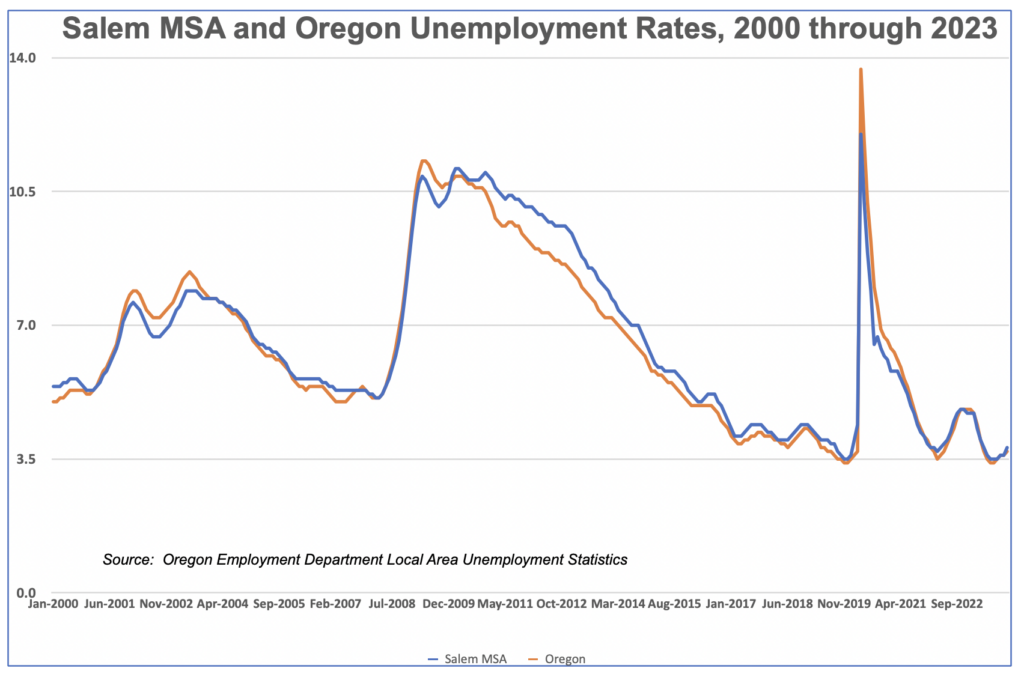A look back at the Salem area economy over the past four years provides a lot of good news to report.
Salem area industry employed 184,200 people in December 2023. Additionally, employment increased by more than 5% compared to December 2019 (pre-COVID-19).
Salem’s recovery is stronger than anywhere else in the Willamette Valley, better than the state as a whole, and better than the nation (see table below).

Employment in Multnomah County remains 2% behind where it was in December 2019, leaving the leisure and hospitality industry with a significant number of jobs short of pre-pandemic levels. Lane County’s leisure and hospitality industry and local government (which counts University of Oregon employment) have not recovered from pre-pandemic levels as of December 2023.
A variety of industries in the Salem area are contributing to a healthy recovery in employment (see pie chart).

Two examples stand out. Salem is the state capital, so half of the state’s total employment (about 20,000 people) is located here, and state government employment has remained stable during the pandemic.
Additionally, leisure and hospitality employment is a slightly smaller share of total employment than in other regions of the Willamette Valley. Because of these two factors, employment in Salem did not decline significantly and recovery was not far off.
Let’s take a closer look at industry employment in the Salem Metropolitan Statistical Area (Marion and Polk Counties), then examine some of the other factors that contribute to Salem’s economic health.
The industries with the largest share of employment (after government) are health care and social assistance.
The industry lost some jobs early in the pandemic as doctors and dentists temporarily closed their offices or limited their hours. Most jobs recovered fairly quickly, and overall industry employment recovered. However, further investigation revealed a problem.
The employment numbers above are based on monthly surveys. Find out more about the healthcare industry by viewing the Oregon Employment Department’s Actual Employment Count, Quarterly Employment and Wage Census. As of the third quarter of 2023 (the latest report available), employment in ambulatory care, physician, and dental offices was several hundred fewer than before COVID-19. And employment in nursing homes and residential care facilities narrowly edged out employment by just a few jobs.
As an important side note, not only have health care workers borne the brunt of the coronavirus, but many have also worked in low-paying jobs. According to the Oregon Employment Department’s 2019 Wage Survey, 40% of health care workers earned less than the median wage for all occupations ($19.27 an hour), and the remaining 8% earned just a penny or more. As I will discuss later in this column, although there have been raises, the stress on health care workers has not been alleviated.
Another big industry in terms of employment is trade, transportation and utilities, but the trends here are mixed. The industry as a whole has seen several job losses from before the coronavirus until the end of 2023. That’s because the largest sector, retail (62% of industry employment), has shed nearly 1,000 jobs. The retail industry was struggling even before the coronavirus outbreak, and the rise in online shopping during the pandemic hasn’t helped restore jobs.
The bright spots in the industry are warehousing and transportation. According to the Quarterly Employment and Wage Statistics Survey, from the third quarter of 2020 to the third quarter of 2023, this industry sector increased employment by more than 50%. Trucking also increased employment by 30% during this period.
The majority of Salem-area workers are employed in construction and manufacturing, and both industries have weathered the economic disruption caused by the pandemic fairly well.
Construction employment has increased by 1,000 people over the past four years. It remains to be seen whether these profits will be enough to fund the construction of additional housing from the governor’s budget. According to the National Association of General Contractors, there is a severe shortage of construction workers nationwide.
Manufacturing employment is down by about 1,000 jobs, largely due to the shrinking food processing industry in the Salem area in recent years.
Although the leisure and hospitality industry is a small part of Salem’s economy in terms of employment, it lost half of its employment in the first few months of 2020, far more than any other industry. The employment recovery occurred quickly but was hampered by a second brief business shutdown at the end of 2020 during another surge in coronavirus infections. Still, employment remains almost 4% above pre-pandemic levels.
And finally, the professional services, business services, administrative services, and support services sector, which is mostly staffing agency employment, has grown significantly over the past 20 years, from 5,500 people in 2001 to 9,200 people in 2023. It has almost doubled. As of December 2023, the staffing agency had increased employment by 1,400 people from pre-pandemic levels.
So, employment is strong, but what about the unemployment rate?
For most of 2023, the unemployment rate was below 4%, a historic low (see chart below). The only time since 2000 that Salem’s unemployment rate was below his 4% was in the months just before the pandemic hit.

Wage trends are particularly good news for low-wage workers. It has been primarily low-wage workers who have felt the greatest stress and strain from the coronavirus economy. They were the most commonly laid off workers and worked in jobs that could not be done from home, exposing them to constant exposure to the coronavirus. As the coronavirus subsided, employers realized they needed to raise wages to bring these workers back to work and increase wages, and they did. (See Table 2)
From 2019 to the third quarter of 2022, Marion County saw a dramatic decline in the percentage of workers making less than $15 an hour, and an increase in the percentage of workers making more than $30 an hour. This is literally a numerical representation of low-wage workers moving up the wage ladder.
There was also a slight upward trend in the higher salary ranges, but it was not as dramatic as in the lower salary ranges.

In addition to the impressive jobs recovery, low unemployment rate, and rising wages, there is one last piece of good news. Consumers are no longer pessimistic about the economy, according to the University of Michigan Consumer Sentiment Index. The index’s figures show that even last year, when the economy had improved dramatically in recent years, gloom remained the norm. Consumer sentiment has finally caught up with a healthy economy.
And one more thing: January’s growth in U.S. employment, which is announced on the first Friday of the previous month, is nothing short of astonishing. Oregon and the Salem area are likely to see similar steady job growth.
Pam Ferrara of the Willamette Workforce Partnership maintains a regular column examining local economic issues. You can contact her at: [email protected].
Story tips or ideas? Email Salem Reporter’s news team at: [email protected].
Please support our work – We rely on our subscribers for the resources to report on Salem carefully, in-depth, fairly and accurately. Subscribe now to get our daily newsletter and more. Click “I want to subscribe!”

Pamela Ferrara is an adjunct fellow with the Willamette Workforce Partnership, the region’s local workforce committee. She worked in research at the Oregon Employment Department in Ferrara, she holds a master’s degree in labor economics, and she speaks fluent Spanish.
#Column #Salem #ahead #Oregon #pandemic #economic #recovery #Salem #Reporter